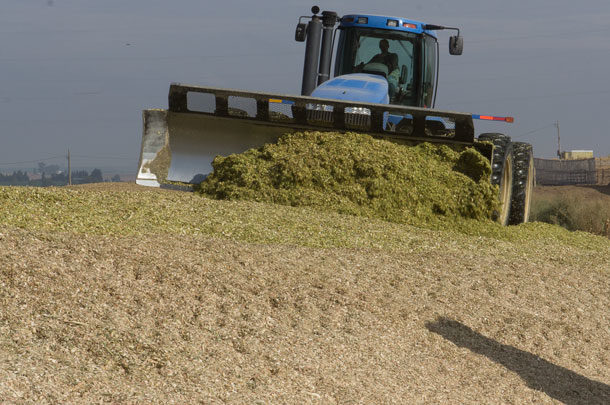The purpose of this article is to investigate the management practices and weather conditions that impacted the yield and quality variances seen across Canadian corn silage crops.
Table 1 shows the variances in the four-year eastern and western Canada combined corn silage plot data, and Figure 1 compares corn silage quality in 2015 to 2014.

 Data from 1,167 sample submissions from corn silage plots and several hundred fresh corn silage sample submissions to A&L Laboratories in London, Ontario, shows an average 3 percent increase in dry matter that likely contributed to the 3 percent increase in starch content.
Data from 1,167 sample submissions from corn silage plots and several hundred fresh corn silage sample submissions to A&L Laboratories in London, Ontario, shows an average 3 percent increase in dry matter that likely contributed to the 3 percent increase in starch content.
The increased starch combined with 2 percent decreased neutral detergent fibre digestibility (NDFD) resulted in the increased milk-per-ton and milk-per-acre value for the 2015 crop.
Utilizing the Pioneer Corn Silage Value Calculator, adapted from work by Dr. Jim Linn of University of Minnesota Extension, corn silage value increased from $63 per ton to $67 per ton with the majority of the additional value being sourced from 3 percent higher dry matter and 3 percent higher starch.
While quality and yield have increased on average, the variance lines on each bar in Figure 1 demonstrate the 45 percent increase in corn silage sample variability year over year. While genetics will impact corn silage quality and yield variability, the following environmental events had a more significant impact on the quality and yield of your 2015 silage crop.
- Plant emergence: For many growers, the 2015 season started off with perfect planting conditions. Research shows corn planted on May 9 established a 15.6 percent yield potential advantage over corn planted in late May of 2014.
Early planting in spring is extremely important in maximizing the yield and quality potential of a corn hybrid. 2014 harvest conditions presented challenges for planting the 2015 crop. There were compaction issues from wet conditions and late harvest that allowed little time for fall tillage.
Cold winter conditions and producers with high residue levels resulted in slow soil warming in the spring. Corn seed planted in cold conditions is a concern as prolonged cold temperatures can lead to poor germination and increases risk of attack from pests and disease.
Luckily, few cases of poor germination were reported. This was likely due to the continuous warming trend throughout May. Hybrids with higher stress emergence ratings and use of proper seed treatment to protect seeds from early spring pests such as corn rootworm, wireworm and soil grubs improves germination of the crop during cool spells in the spring.
For proper germination, seeds must be sowed into the soil with adequate presence of moisture. The drought conditions in May led many growers to re-calibrating planters for the proper pressure to achieve 2.5- to 3-inch seeding depth where moisture was present.
 Corn that was seeded too shallow had slow or uneven emergence as seeds waited for moisture to germinate. As shown in Figure 2, uneven plant germination can lead to 79 to 94 percent of potential yield of the corn silage crop.
Corn that was seeded too shallow had slow or uneven emergence as seeds waited for moisture to germinate. As shown in Figure 2, uneven plant germination can lead to 79 to 94 percent of potential yield of the corn silage crop.
- Frost damage led to uneven plant stages of growth and reduced yield potential. Spring frost damage was the next challenge Mother Nature presented to the corn silage crop.
Due to cold soil temperature exchange with slightly higher air temperatures, microenvironments close to soil surface led to low air movement and, thus, variable frost damage within the crop. Frost damage was variable within rows and across soil topography.
While research has shown corn at the first four-leaf stages can survive a frost event as long as the growing point is below soil surface, plants at the four-leaf stage are transitioning from deriving their nutrients from the seed to their preliminary root system.
The drought stress in May further aggravated the poor regrowth of damaged frosted plants. This “runting” effect of plant growth due to frost damage would have a similar effect to uneven plant emergence, as displayed in Figure 2.
- Wet, cool conditions prior to silking resulted in lower NDFD. Wet conditions prior to tassel play a significant role on NDFD, as it results in greater lignification in the stalk of the plant. Hot dry conditions, on the other hand, improve NDFD.
During 2015, 3 inches more rain fell in June over the month compared to the 10-year average for most regions of Canada. These high moisture levels for the majority of the growing season prior to tassel, coupled with greater sunlight exposure, heat and comparable rainfall to 2014, leads one to predict that the growing season had the same influence on NDFD this year as 2014.
Your corn silage sample variance in NDFD from the average could be due to chop height at harvest, soil fertility, hybrid, silage inoculant and storage conditions.
Monitor your herd’s intake and production responses as you transition to 2015 corn silage to allow your nutritionist to fine-tune the paper ration based on true digestibility response.
At the same time, be sure to sample the 2015 corn silage as soon as possible for forage analysis and compare to 2014 corn silage reports to see how dry matter, NDFD, starch content and degree of kernel processing differs between the two crops. This permits your nutritionist to tailor the formulation of dairy rations based on these silage report comparisons.
- Variability in starch and overall tonnage related to nitrogen deficiency. A dry planting season quickly changed with record rainfalls across Canada. Heavy rainfalls in June resulted in water-saturated fields for several days at a time.
Normally, soil microbes break down organic matter for energy supply. However, with saturated soils, microbes utilize nitrogen from the soil, allowing N to move from soil structures into the atmosphere (also called denitrification) as well as leach into drainage systems.
Forty percent of the total nitrogen utilized by the corn plant occurs after silking and, thus, nitrogen supply later in season is critical for maximizing yield.
Growers who performed tissue and soil sampling, and responded with nitrogen side-dressing, were able to replenish N levels in the soil to maintain the ear girth and kernel number, which is determined at the six-leaf stage. Since any nutrient deficiencies at six-leaf stage or silking greatly impact yield, early leaf firing (signs of N deficiency) during these stages signal a dire need for nitrogen to meet yield potential.
- Harvest conditions led to more mature silage, greater dry matter and more starch deposition. Several factors led to rapid drydown and hastened corn silage maturity.
Nitrogen availability in the soil and hybrids with drought resistance and strong plant health were able to continue drydown and starch deposition at a normal rate. With hot, sunny conditions throughout mid-August and September, research indicates that an additional 1 percent starch was deposited daily as corn dried down 0.5 to 1 percent per day for hybrids with good, late-season plant health traits.
However, stressed hybrids with lower late-season plant health resulted in early shutdown. This was observed by leaf death while kernels are still within the milk-line stage.
Silage samples averaged 39 percent DM, some being submitted as dry as 50 percent. This can be a concern for stability in storage, as slow fermentation is more likely in combination with poor aerobic stability at feedout.
Silage feedout rates may need to be increased by a higher corn silage inclusion in the ration to minimize silage heating during the summer months.
Research has shown how silage inoculation with L. buchneri can greatly reduce heating from yeast activity, prolonging bunk life properties on the silo face and in the ration, which can decrease dry matter losses up to 60 percent from field to feed.
The success of your corn silage crop takes thorough planning and timely action from seed to feed. Work closely with your nutritionist and corn sales representative to manage corn silage inventories and quality throughout 2016 and to maximize your milk-per-acre results in the 2016 growing season. PD
References omitted due to space but are available upon request. Click here to email an editor.

-
Ashley Hall
- Dairy Specialist Western Ontario
- Dupont Pioneer
- Email Ashley Hall











